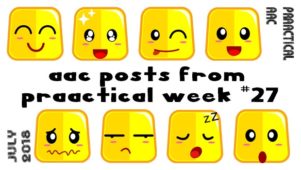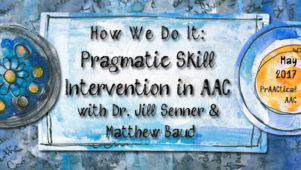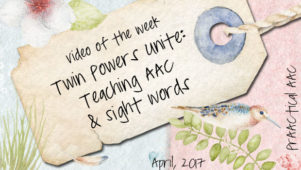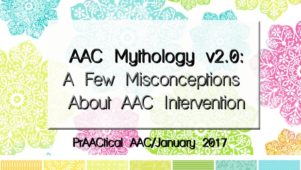Speaking Up- Too Late?

 AAC & The Art of the Unconventional Conversation, Carole’s post from Saturday, recounts a young girl who some people might have thought was not ready for AAC. It reminds me a young man I know, Michael. I met Michael when he was 14, after he was discharged from all of his communication intervention or I should say his speech-language therapy sessions. He was discharged at school because when he moved from his autism classroom in middle school to a high school classroom for children with varying exceptionalities, it was ‘felt’ that he did not need it anymore. He had not made ‘progress’ in his speech and language goals, he did not talk, he did not consistently identify objects, and he did not essentially do a lot of things. He
AAC & The Art of the Unconventional Conversation, Carole’s post from Saturday, recounts a young girl who some people might have thought was not ready for AAC. It reminds me a young man I know, Michael. I met Michael when he was 14, after he was discharged from all of his communication intervention or I should say his speech-language therapy sessions. He was discharged at school because when he moved from his autism classroom in middle school to a high school classroom for children with varying exceptionalities, it was ‘felt’ that he did not need it anymore. He had not made ‘progress’ in his speech and language goals, he did not talk, he did not consistently identify objects, and he did not essentially do a lot of things. He  was discharged from his private therapy as he was not making progress in a lot of goals there either. Everyone appeared to love Michael and his family. Michael did not have any challenging behavior, he was compliant with all tasks. His family was very supportive and easy to work with. They never complained but asked good questions and were involved and attempted to do all of the ‘speech homework’ that was assigned. But…. everyone said Michael was not making progress and therefore needed to be discharged. This is when I met Michael. He was seen for an assessment and the evaluators at our clinic thought AAC intervention would help Michael develop a communication system (thank goodness).
was discharged from his private therapy as he was not making progress in a lot of goals there either. Everyone appeared to love Michael and his family. Michael did not have any challenging behavior, he was compliant with all tasks. His family was very supportive and easy to work with. They never complained but asked good questions and were involved and attempted to do all of the ‘speech homework’ that was assigned. But…. everyone said Michael was not making progress and therefore needed to be discharged. This is when I met Michael. He was seen for an assessment and the evaluators at our clinic thought AAC intervention would help Michael develop a communication system (thank goodness).
When I met Michael, he had no sounds, no words, no sentences, and certainly no formal communication system. He also had no challenging behavior. Michael basically followed contextual, gestural, and physical directions. He was led around, prompted through tasks, and was definitely not a problem to be with. I thought ok maybe he never had access to a concrete visually based communication system. None was mentioned in any of the previous speech and language progress reports that were still available. Mom said he used ‘those pictures’ when he was little but did not really show any interest. All past therapy goals focused on having Michael identify common objects and actions, turn taking, and following directions. So we (myself and graduate student team) thought he just needed exposure to a good symbol based communication system. We decided (based on assessment information & feature matching analysis) to begin with the Picture Exchange Communication System (PECS). Well, when a young man makes it to 14 with out a communication system, I should have suspected it would not be that easy. Michael really had a difficult time discriminating pictures even to request highly motivating objects and actions. He was great at learning to hand a symbol to an adult to request when there was only 1 choice, but once a distractor symbol was introduced Michael consistently requested with the correct symbol at about 50%. I had to admit after probably too long of a time that 50% was chance responding. Luckily, at this time, we knew much more about Michael’s communication.
Michael definitely had sophisticated and symbolic communication. So what did he do? Two things stood out. At home, he enjoyed bike riding with his dad. Dad and Michael developed a routine. When dad came home from work, he always took Michael for a bike ride. However, some days he could not go immediately. He might have needed to talk to one of Michael’s sisters or brothers, take care of some home tasks, talk to mom, or even relax for a moment. Michael would stand near dad (conversation begins). Dad might say “just wait, we will go in a few minutes”. Michael would then go get Dad’s bike helmet and give it to dad. If dad still did not leave immediately, Michael would go get him a pair of pants and a shirt, and if dad still did not begin to leave Michael would get a bottle of water. At which time, Dad was convinced to change and go bike riding (conversation completed). So not only did Michael begin the conversation with positioning himself near dad, he negotiated for a quicker start time by giving/telling dad that there was no reason to wait since he had brought him all the things he needed and now should be ready to go. The ‘art’ of conversation….
The second thing involved communication about the bathroom. At home, Michael was self -sufficient using the bathroom and never had accidents. The family though had difficulty when they were out. They did not go out too often because a bathroom accident while they were out was a big deal. At school, the situation was different. Michael was taken to the bathroom by a teacher or teacher’s aide. The adult always carried a small shopping bag that contained bathroom materials (soap, wipes, etc). The school staff was happy with Michael because he would go stand by the bag when he had to go to the bathroom. The ‘art’ of conversation…
The’ conversations’ in Michael’s case had something in common that had nothing to do with pictures or words. We deduced that the common denominator in Michael’s conversations were objects…. the helmet, clothes, water, bathroom bag. It made perfect sense then to begin an object communication system.
Michael was not a fast learner at the beginning. However, once an object based communication system (object schedules, communication boards, object labeling, etc.) was introduced, Michael made gradual process. At first his progress was very gradual and then as he had 10 object symbols in his communication repertoire for both expressive and receptive communication his progress started speeding up……
Fast forward 2 1/2 years:
- Michael uses an object symbol to let Mom know when he is sick. He is beginning to use a variety of object symbols to discriminate telling mom what type of illness he might have.
- Michael requests the bathroom whether at school, home, or in the community using an age appropriate small backpack. (This was mom’s most appreciated accomplishment).
- Michael uses an object symbol to request ending a task when he does not want to do them anymore.
- Michael requests music by genre with object symbols.
- Michael uses object symbols to request specific ingredients to cook his favorite food by following an object recipe.
- Michael completes chores independently via object schedules
- Michael has just begun using picture symbols to request snack food and drinks.
- Michael has just begun to use the iPad an AAC app (Tap to Talk) to request activities and objects.
To Late for AAC, the data says otherwise…
Filed under: PrAACtical Thinking
Tagged With: intervention
This post was written by Robin Parker




